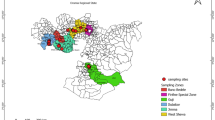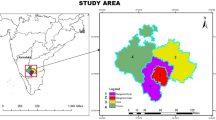Abstract
Bumble bees are known to be amongst the most efficient natural pollinators and their increased scarcity in the ecosystem has led us to study their habitat and ethological preferences, so that future efforts can be designed for their restoration under the natural habitat. The present investigation explores the natural nest architecture, structural features of nest habitat, location of the nest, environmental parameters, population dynamics, emergence of drones, gynes, and variation in the sex ratio of Bombus haemorrhodalis. A total of ten natural nests were excavated at different altitudes ranging from 473.05 to 1258.52 m from different sites in two locations Nauni and Gandhal. The species inhabited the underground abandoned rodent’s cavities as nests at a depth of 15 cm to 140 cm with 1–2 external hidden entrances or below ground covered with involucrum made of small dried grass, leaves, pine needles, paper infused on/with wax, etc. The shape of the nest varied from circular to oval with an average size of about 3.88 cubic decimeters. The colony strength of all excavated nests ranged between 15 and 113 individuals, with average internal ambient temperature and relative humidity of the nest cavity varying from 20.9–29.7 °C and 24.6–79.3 percent, respectively. The honey storage (length x width; 16.02 × 15.74 mm), queen (15.02 × 14.60 mm), worker (13.25 × 12.58 mm) and drone cells (11.13 mm × 10.45 mm) varied in dimensions and were constructed by the workers with colony development. As a potential natural strategy to ensure survival, the gynes emerged earlier and higher in number than drones in late summer to early autumn and this progeny survived until the end of autumn. The current study exploring the natural environment of B. haemorrhoidalis helps understand and correlate the natural nest characteristics with laboratory-reared colonies for year-round rearing.

Similar content being viewed by others
References
Belsky JE, Camp AA, Lehmann DM (2020) The importance of males to bumble bee (Bombus Species) nest development and colony viability. Insects11 (506):1–16. https://doi.org/10.3390/insects11080506. PMID: 32764336; PMCID: PMC7469185
Cameron S, Jost M (1998) Mediators of dominance and reproductive success among queens in the cyclically polygynous neotropical bumble bee Bombus atratus Franklin. Insec Soc 45(1):135–149. https://doi.org/10.1007/s000400050075
Cameron SA, Whitfield JB, Cohen M, Thorp N (1999) Novel use of walking trails by the amazonian bumble bee, Bombus transversalis (Hymenoptera: Apidae). In: Byers GW, Hagen RH, Brooks RW (eds) Entomological contributions in memory of Byron A. University of Kansas, Natural History, Museum Special publication, Alexander, pp 187–193
Carnell JD, Hulse RA, Page S, Goulson D, Hughes WHO (2020) Effect of diet on incipient colony success for two long-tounged bumblebee species in the laboratory. Insec Soc 67:531–539
Chauhan A (2011) Refinement of bumble bee rearing technology and its use in cucumber pollination. Dissertation, Department of Entomology, Dr Yashwant Singh Parmar University of Horticulture and Forestry, Nauni, Solan
Chauhan A, Katna S, Rana BS (2013) Ethological studies on bumble bees under subtropical conditions in India. J Med Sci Clin Res 1(3):125–129
Chauhan A, Rana BS, Katna S (2014) Successful rearing of bumblebee, Bombus Hamorrhoidalis Smith year round rearing in Himachal Pradesh. Int J Curr Res 6(12):10891–10896
Chauhan A, Thakur RK (2010) Studies on the nest architecture of the bumble bee Bombus haemorrhoidalis Smith. Pest Manage Econ Zoo 18(1/2):145–149
Devi D (2019) Studies on nesting material and carbon dioxide narcosis on domiciliation of bumble bee (Bombus haemorrhoidalis Smith). Dissertation, Department of Entomology, Dr Yashwant Singh Parmar University of Horticulture and Forestry, Nauni, Solan
Duchateau MJ, Marien J (1995) Sexual biology of haploid and diploid males in the bumblebee Bombus terrestris. Ins Soc 42:255–266
Duchateau MJ, Velthuis HHW, Boomsma JJ (2003) Sex ratio variation in the bumblebee Bombus terrestris. Behav Eco 15(1):71–82
Duvosin N, Baer B, Paul S (2002) Sperm transfer and male competition in bumble bees. Anim Behav 58(4):743–749
Gomez KA, Gomez AA (1984) Statistical procedure for agricultural research, 2nd edn. John Wiley and Sons, New York, pp 357–427
Gonzalez V, Mejia A, Rasmussen C (2004) Ecology and nesting behavior of Bombus atratus Franklin in Andean Highlands (Hymenoptera: Apidae). J Hymenopt Res 13(2):234–242
Goulson D (2003) Bumblebees: their Behaviour and Ecology. Oxford University Press, Oxford, p 235
Hoffmann WRE, Torres A, Neumann P (2004) A scientific note on the nest and colony development of the Neotropical bumble bee Bombus (Robustobombus) melaleucus. Apidologie 35(1):449–450. https://doi.org/10.1051/apido
Kaushal B (2020) Studies on bumblebee (B. haemorrhoidalis Smith) pollination in strawberry. Dissertation, Department of Entomology, Dr Yashwant Singh Parmar University of Horticulture and Forestry, Nauni, Solan
Kells AR, Goulson D (2003) Preferred nesting sites of bumblebee queens (Hymenoptera: Apidae) in agroecosystems in the UK. Biol Conserv 109(2):165–174
Milano NJ, Iverson AL, Nault BA, McArt Scott H (2019) Comparative survival and fitness of bumblebee colonies in natural, suburban and agricultural landscapes. Agric Ecosyst Environ 284:106594
Nasir M, Ata-ul-Mohsan, Ahmad M, Saeed S, Aziz Muhammad A, Imran M, Aslam Sheikh UA (2019) Effect of different temperatures on colony characteristics of Bombus terrestris (Hymenoptera: Apidae). Pakistan J Zool 51(4):1315–1322
Nayak RK (2018) Studies on bumble bee pollination in kiwifruit (Actinidia deliciosa Chev.). Dissertation. Dissertation, Department of Entomology, Dr Yashwant Singh Parmar University of Horticulture and Forestry, Nauni, Solan
Nayak RK, Rana K, Sharma HK, Thakur S, Singh P, Thakur M (2020) Rearing of Indian native bumble bee (Bombus haemorrhoidalis Smith) in mid hill conditions of Himalaya. J Entomol Zool Stud 8(4):1208–1212
Negi N (2022) Diversity and altitudinal food preferences of bumblebee species in different agro-climatic zones of Himachal Pradesh. Dissertation, Department of Entomology, Dr YS Parmar University of Horticulture and Forestry Nauni, Solan H.P
O’Corner SA (2013) The nesting ecology of bumblebees. Dissertation, The institute of Biological and Environmental Sciences School of Natural Sciences. The University of Stirling
Owen RE, Plowright RC (1982) Worker-queen conflict and male parentage in bumble bees. Behav Ecol Sociobiol 11:91–99. https://doi.org/10.1007/BF00300097
Padilla SC, Cure JR, Riano Diego A, Gutierrez Andrew P, Rodriquez D, Romero E (2017) Gyne and drone production in B.atratus (Hymenoptera: Apidae). J Apic Sci 61(1):55–72
Paxton RJ, Thoren PA, Estoup A, Tengo J (2001) Queen-worker conflict over male production and the sex ratio in a facultatively polyandrous bumblebee, Bombus hypnorum: the consequences of nest usurpation. Mol Ecol 10(10):2489–2498
Pelletier L, McNeil NJ (2003) The effect of food supplementation on reproductive success in bumblebee field colonies. OKIOS 103(3):688–694
Saini MS, Raina RH, Khan ZH (2011) A check list of bumblebees (Hymenoptera: Apidae) from Indian Himalaya. J Insec Sci 24:326–352
Sakagami SF (1976) Specific differences in the bionomic characters of bumblebees: a comparative review. J Fac Sci Hokkaido Univ Ser VI Zool 20(3):390–447
Sharma HK, Kalia L, Sharma R, Thakur M, Prasad H, Devi M, Thakur P, Sharma D, Rana K (2021) Seasonal incidence, epidemiology and establishment of different pests and disease in laboratory reared Bombus haemorrhoidalis Smith. Int J Trop Insect Sci 41(16):1–10
Sharma HK, Thakur S, Rana K, Thakur M (2018) Small scale rearing of Bombus Hamorrhoidalis Smith. Pharma Innov 7(11):41–45
Singh N (2017) Palynological studies on bumble bee flora under mid-hill conditions of Himachal Pradesh. Dissertation, Department of Entomology, Dr Yashwant Singh Parmar University of Horticulture and Forestry, Nauni, Solan
Streinzer M, Chakravorty J, Neumayer J, Megu K, Narah J, Schmitt T, Bharti H, Spaethe J, Brockmann A (2019) Species composition and elevational distribution of bumble bees (Hymenoptera, Apidae, Bombus Latreille) in the East Himalaya, Arunachal Pradesh, India. Zookeys 851:71–89
Taylor OM, Cameron SA (2003) Nest construction and architecture of the amazonian bumble bee (Hymenoptera: Apidae). Apidologie 34:321–331. https://doi.org/10.1051/apido:2003035
Thakur RK (2002) First attempt to study nest architecture and domiciliation of bumblebee (B.haemorrhoidalis) in India. In: 6th Asian Apicultural Association International Conference and World Apiexpo. Banglore, India. 24th February to 1st March. p. 172
Thakur RK (2010) Bumble bee rearing technology in India: present scenario and future strategies. In: National Symposium on Perspectives and Challenges of Integrated Pest Management for Sustainable Agriculture, November 19–21 at Dr Yashwant Singh Parmar University of Horticulture and Forestry, Nauni, Solan
Thakur RK, Kashyap L (2007) Some studies on bumble bee, Bombus haemorrhoidalis Smith nests under mid-hill conditions of Himachal Pradesh. Ind Bee J 69(1–4):100–102
Thakur S (2018) Studies on bumble bee (Bombus haemorrhoidalis Smith) pollination in Capsicum annuum under protected cultivation. Dissertation, Department of Entomology, Dr Yashwant Singh Parmar University of Horticulture and Forestry, Nauni, Solan
Thakur S, Sharma HK, Rana K, Thakur M, Sharma MK, Nayak RK (2021) Bombus Hamorrhoidalis Smith, a potential pollinator in bell paper (Capsicum annum L. var Solan Bharpur) under protected cultivation. Ind J Hort 78(1):84–87
Williams PH, Cameron S, Hines HM, Cederberg B, Rasmont P (2008) A simplified subgeneric classification of the bumblebees (genus Bombus). Apidologie 39:46–74
Yankit P (2016) Studies on bumble bee pollination in tomato (Solanum lycopercicum Mill.) under protected condition. Dissertation, Department of Entomology, Dr YSP university of Horticulture and Forestry, Nauni, Solan
Funding
The authors are grateful to world Bank funded Project; Himachal Pradesh Horticulture Development Project (HP-HDP-Component: Managed Pollination) and All India Coordinated Research Project on Honey bees and Pollinators, ICAR, New Delhi for providing financial assistance to carry out this research. AICRP on Honeybees and Pollinators, World Bank Group (HP-HDP; Managed pollination).
Author information
Authors and Affiliations
Contributions
Conceptualization of research was done by Dr Harish Kumar Sharma, Dr Kiran Rana and Dr Meena Thakur; Experiments were designed by Dr Harish Kumar Sharma and Dr Ruchi Sharma; Data collection and experiments were conducted by Dr Ruchi Sharma, Dr Hema Prasad and Dr Deeksha Sharma, Data analysis and interpretation was done by Dr Ruchi Sharma and reviewing of literature was done by Dr Priyanka Thakur and Ms Diksha Devi; and manuscript was prepared by Dr Ruchi Sharma.
Corresponding author
Ethics declarations
Conflict of interest
The authors declare no conflict of interest.
Additional information
Publisher's Note
Springer Nature remains neutral with regard to jurisdictional claims in published maps and institutional affiliations.
Rights and permissions
Springer Nature or its licensor (e.g. a society or other partner) holds exclusive rights to this article under a publishing agreement with the author(s) or other rightsholder(s); author self-archiving of the accepted manuscript version of this article is solely governed by the terms of such publishing agreement and applicable law.
About this article
Cite this article
Sharma, H.K., Sharma, R., Prasad, H. et al. Ethological studies of bumble bee, Bombus haemorrhoidalis Smith under low hill conditions in Himachal Pradesh. Int J Trop Insect Sci 44, 669–679 (2024). https://doi.org/10.1007/s42690-024-01190-z
Received:
Accepted:
Published:
Issue Date:
DOI: https://doi.org/10.1007/s42690-024-01190-z




